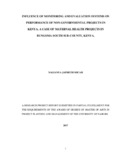| dc.description.abstract | The growth in number and size of non-governmental organizations in Kenya has been met with a growing concern about identifying their achievements and effectiveness of their projects. The struggle by majority of Non-governmental organizations to account for their work and demonstrated real results continues to taint their image as development change agents to various stakeholders. One of the ways in which organizations can improve effectiveness of their interventions is by strengthening their monitoring and evaluation systems. This study sought to determine the influence of monitoring and evaluation systems on performance of non-governmental based maternal health projects in Bungoma South Sub-County, Kenya. The objectives were to: determine how monitoring and evaluation plans, human Resource capacity, nature of monitoring and evaluation information systems adopted, and stakeholder participation in monitoring and evaluation influence performance of non-governmental maternal health projects in Bungoma South Sub-County. A descriptive survey design and correlation design was employed. With a target population of 101 respondents, a census was conducted on all respondents involved in implementation of maternal health projects from three non-governmental organizations (Ace Africa (Kenya), Save The Children (Bungoma), and Community Research in Environmental and Development Initiatives). Data was collected through questionnaires and analyzed using descriptive statistics. The study concluded that M&E plans influences performance of the projects as shown by a fairly strong correlation of 0.607. Although human resource capacity in monitoring and evaluation is key in performance of the projects, a moderate correlation coefficient of 0.530 established implies low M&E expertise in the organizations. The study also showed monitoring and evaluation information system influences performance of the projects. However, with a correlation coefficient of 0.533, there is room for improving the current information systems to in the three organizations to make them more efficient. The study further showed that too much stakeholder involvement in M&E had a negative influence on performance of the projects in the long-run. This was shown by a correlation coefficient of -0.489. A regression analysis indicated that, taking all the independent variables at a constant zero, performance of maternal health projects was 4.087. In overall, it was therefore concluded that monitoring and evaluation systems influences performance of the projects. The study recommends alignment of staff job descriptions with their M&E plans, increase the number of M&E training, conduct Routine Data Quality Assessment to detect areas of difficulties to staff, invest in Information and Communication Technology, and manage stakeholders’ involvement in Monitoring and Evaluation in order to achieve quality data. | en_US |



